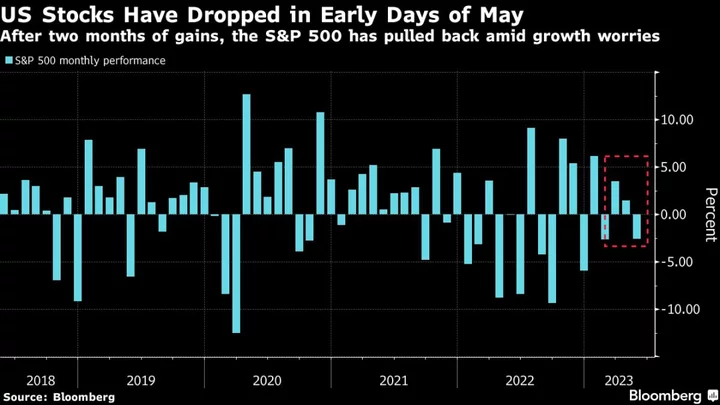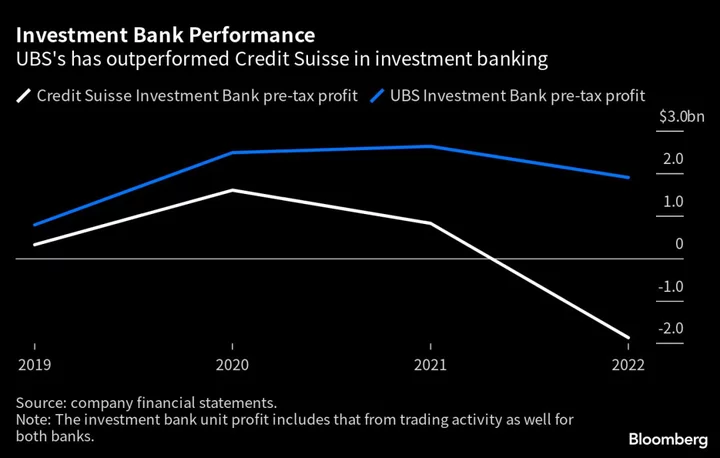For a fleeting moment this month, investment bankers in leveraged finance — the lucrative lending that oils the wheels of M&A and feeds the $1.3 trillion market for collateralized loan obligations — had rare cause for cheer. Company valuations were enticingly low for dealmakers, the US Fed looked closer to reversing punishing rate hikes, loans were getting done.
A realization that Federal Reserve Chair Jay Powell isn’t ready to turn quite yet has put those Wall Street hopes on ice. Financing packages are stalling again. A CLO industry that boomed in the cheap money era, by bundling up slices of loans and selling them as bonds, looks particularly vulnerable to the freeze.
Through a decade of low rates, bankers turned CLOs from niche securitizations into a capital markets pillar and one of the hottest finance products around. Now, much of the industry’s shrinking, starved of its usual feedstock of loans in a moribund M&A market. Demand from big US commercial banks for the largest tranche of CLOs has also cratered; better returns are on offer elsewhere.
About 40% of the securities’ issuers have yet to price a new deal this year, according to data from Citigroup Inc. “The CLO market has been gummed up for a while,” says Andrew Lennox, an investor at Federated Hermes Limited.
This isn’t just a tale of woe for finance whiz kids. The impact from any prolonged shutdown — especially on extending the life of existing bundles of loans — would hit the real economy, too, making it tougher for lower-rated businesses to refinance at a time when traditional lenders are pulling back.
“Lower CLO creation will lead to lower demand for leveraged loans,” says Wayne Hosang, portfolio manager at alternative credit firm Crescent Capital, which “means underwriting banks will find it harder to place new leveraged buyout paper and borrowers will find it more challenging to refinance.”
Companies have roughly half-a-trillion dollars of leveraged loans coming due in the next three years, and CLOs control about 70% of the US corporate-loan market. It’s more than that in Europe.
Slow Lane
Nor are there signs of rescuers on the horizon. Bank appetite is starting to return and the leveraged loan market is open, but for “higher-quality issuers,” says Dan Hayward, a portfolio manager of US liquid credit at Ares Management. CLOs are mostly made up of riskier lending.
“The CLO market right now is like the ‘ole family station wagon, it’s plodding along,” says Scott Macklin, head of leveraged-loan strategy at AllianceBernstein LP, “To shift the CLO creation machine back into the fast lane will take the nitrous oxide of a material tightening of AAA spreads and/or widening loan spreads.” In short, premiums on other investment-grade bonds look better.
This is all bad news for investment bankers, who built a Wall Street profit machine during the buyout boom years by arranging and underwriting money-spinning loans to private equity-owned companies — and then helping create the securities that gobbled up slices of that debt.
Read More: Junk Loan Sales in Europe the Weakest Since 2010
Many CLO management firms are suffering as well. Falling demand makes it difficult to refinance their existing securities. In happier days some managers hoped their ability to “reset” existing loan bundles, extending repayment into the future, had put them on a path to investment’s holy grail: permanent capital. The new trend is the opposite: investors closing, or “calling,” CLOs.
“It could start to look as it did before the financial crisis, when calling CLOs was the norm,” says Simon Gold, a senior trader in the bonds at Chenavari Investment Managers. “After 2008, managers started doing more resets extending the life of the securities and taking advantage of the low interest-rate environment. But now that isn’t such an easy path.”
The total issuance of new deals and the refinancing of old ones has dropped to roughly $102 billion so far this year in the US, according to data compiled by Bloomberg. That compares with about $134 billion in the same timeframe last year and almost $350 billion in 2021, the height of the buyout boom.
Buyers Beware
CLOs are divided into tranches, with the senior portion rated as investment grade, the mezzanine part below that and an equity slice making up the riskiest layer. Recently big buyers of the senior tranche — more than 60% of the instrument’s structure — have backed off, happy with the returns they can get from other, more vanilla, assets at a time of normalized central bank rates.
The chief acquirers of that senior AAA portion have been US commercial banks including JPMorgan Chase & Co., Citi, Wells Fargo & Co., and to a lesser extent Bank of America Corp. They’ve stopped buying, or cut purchases to the bone. Mired in new US capital rules and spooked by the failures of Silicon Valley Bank and Credit Suisse, there’s little sign they’ll return any time soon.
Representatives for JPM, Citi, Wells Fargo and BofA declined to comment.
“The lack of CLO creation is a lack of demand for AAAs,” says Joshua Easterly, co-founder of Sixth Street Partners, speaking at the recent Bloomberg Credit Forum in London. “A lot of that AAA demand came out of US banks who had a lot of excess liquidity. They’re no longer buyers at the moment given their balance-sheet issues.”
Normally, this falling demand would be offset by a drop in prices for leveraged loans. But the shortage of supply is keeping prices elevated, shrinking the so-called “arbitrage” earned by CLOs — essentially what’s left after the monthly interest payments on their bundle of loans — to a more than three-year low of about 175 basis points in August, according to Citi, although it’s picked up slightly since then.
A welcome late-summer tightening of spreads for the AAA portion of CLOs and rise in refinancings was short-lived. The market for these securities “remains challenged by macro uncertainty and interest rate volatility,” says Tetragon portfolio manager Dagmara Michalczuk.
Some managers are being told by their equity investors to sell instead. About $3 billion dollars of loans were sold from CLO structures in July, according to BofA Securities. Meanwhile, just 20 resets have been done in the US so far this year, compared with 33 in the same period last year and 208 in the equivalent 2021 timeframe, according to data compiled by Bloomberg.
Private Saviors
One crumb of comfort for corporate borrowers is private credit, which has gladly stepped in to plug gaps left by reluctant leveraged-loan investors.
Direct-lending behemoths including Oak Hill Advisors and Blue Owl Capital provided a $4.8 billion fully funded loan as part of Vista Equity Partners’ refinancing of fintech firm Finastra Group Holdings Ltd.’s debt, according to Bloomberg. That deal was struggling for traction among the traditional leveraged-finance crowd.
Private credit firms are also creating their own version of CLOs, yet another threat to the leveraged finance bankers’ money machine. However, for all their burgeoning strength, it’s yet to be seen whether direct lenders can fill all of the space left by departing CLOs and their US bank backers.
“I think the CLO market’s more of the tail and the loan market’s more of the dog,” says Ian Smith, a colleague of Hayward’s at Ares. “You need the loan market to be functioning more so than the CLO market.”
Any leveraged-finance bankers seeking a swift return to the halcyon days of abundant buyouts will need patience, according to their bosses. A dealmaking revival still looks “a little further away,” Barclays Plc’s Chief Executive Officer C.S. Venkatakrishnan told Bloomberg’s In the City podcast recently.
Morgan Stanley’s James Gorman, who’s been anticipating a rebound in M&A and capital raising, told his bank’s earnings call last week that he’d loved a comment he’d heard: “For all the talk of green shoots, somebody’s got to water them.”
Author: Lisa Lee, Carmen Arroyo and Neil Callanan









